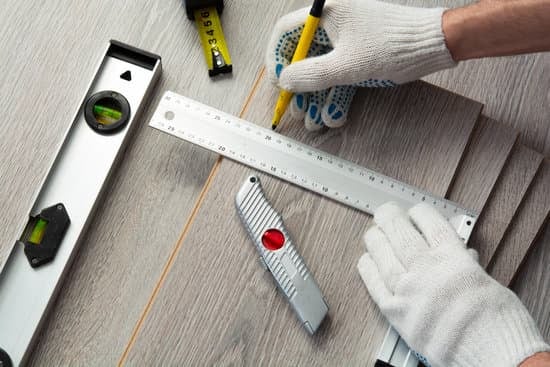Are you wondering, “Can I claim home improvement on taxes?” If so, understanding the rules and regulations surrounding home improvement expenses is crucial. Homeowners may be eligible to claim certain home improvement expenses on their taxes, which can lead to valuable deductions or credits.
When it comes to claiming home improvement on taxes, eligibility is a key factor. Certain criteria must be met in order to qualify for claiming home improvement expenses. This includes the type of improvement, the purpose of the improvement, and whether the improvement adds value to your home.
There are various types of home improvement expenses that can potentially be claimed on your taxes. From energy-efficient upgrades to medical renovations, it’s important to know which expenses may be eligible for tax benefits. Keeping thorough documentation and records of these expenses is essential in order to substantiate your claims during tax season. Additionally, avoiding common mistakes when claiming home improvement expenses can help homeowners maximize their tax benefits while staying compliant with IRS regulations.
Eligibility for Claiming Home Improvement on Taxes
When it comes to claiming home improvement expenses on your taxes, it’s important to understand the eligibility criteria. In general, you may be eligible to claim home improvement expenses on your taxes if the improvements were made for medical reasons, to accommodate a disability, or for energy-efficiency purposes. However, it’s crucial to consult with a tax professional or accountant to determine your specific eligibility.
For medical and disability-related home improvements, you can typically claim these expenses as medical deductions on your taxes. This can include things like adding wheelchair ramps, modifying bathroom facilities for accessibility, or installing medical equipment in your home. Keep in mind that there are certain limitations and requirements for claiming these expenses, so be sure to thoroughly review the IRS guidelines or seek professional advice.
In the case of energy-efficient home improvements such as solar panel installations or energy-efficient heating and cooling systems, you may be eligible for tax credits rather than deductions. This means that you could potentially receive a dollar-for-dollar reduction in your tax bill rather than just a reduction in taxable income.
Again, it’s recommended to seek guidance from a tax professional to ensure that you meet all the necessary criteria and documentation requirements when claiming these types of expenses.
| Eligible Expenses | Eligibility Criteria |
|---|---|
| Medical and Disability-Related Home Improvements | Must be made for medical reasons or disability accommodations |
| Energy-Efficient Home Improvements | Must meet certain energy efficiency standards set by the IRS |
Types of Home Improvement Expenses That Can Be Claimed
When it comes to understanding home improvement expenses that can be claimed on taxes, it’s important to know which types of expenses are eligible. Here are the types of home improvement expenses that can be claimed:
1. Materials and Labor Costs: Any materials or labor costs associated with the actual renovation or improvement of your home can be claimed on your taxes. This includes things like the cost of building materials, paint, flooring, and the fees paid to contractors or other professionals.
2. Energy Efficient Upgrades: Making energy-efficient upgrades to your home, such as installing solar panels, energy-efficient windows, or a high-efficiency heating and cooling system, may also qualify for tax deductions or credits. These upgrades not only benefit the environment but also provide potential tax benefits for homeowners.
3. Home Office Expenses: If you use a portion of your home exclusively for business purposes, you may be able to claim a portion of the home improvement expenses related to that space. This could include renovations or repairs made to create or maintain a dedicated home office.
It’s important to keep in mind that not all home improvement expenses are eligible for tax claims. For example, general maintenance and repairs typically do not qualify for tax deductions or credits. Consult with a tax professional to determine which specific expenses can be claimed on your taxes based on your individual circumstances.
Documentation and Record-Keeping for Home Improvement Expenses
When it comes to claiming home improvement expenses on your taxes, proper documentation and record-keeping play a crucial role. Keeping accurate and detailed records of your home improvement projects can help you maximize your tax benefits and reduce the risk of an audit.
Receipts and Invoices
The first step in documenting your home improvement expenses is to keep all receipts and invoices related to the project. This includes receipts for materials, labor costs, equipment rentals, and any other expenses incurred during the home improvement process. Make sure to clearly label each receipt with the date, vendor name, type of expense, and amount paid.
Contracts and Agreements
If you hired a contractor or professional service provider for your home improvement project, make sure to keep copies of all contracts and agreements. These documents should outline the scope of work, cost estimates, payment schedules, and any warranties or guarantees offered by the contractor. Having this information readily available can support your claim in case of an audit.
Before-and-After Documentation
In addition to financial records, it’s also helpful to document the before-and-after conditions of your home improvement project. Take photos or videos that clearly show the state of the property before the renovation or repair work began, as well as the completed results. This visual evidence can strengthen your claim for home improvement tax benefits.
By diligently maintaining organized records of your home improvement expenses, you can confidently answer the question “can I claim home improvement on taxes?” with a resounding yes. Proper documentation not only supports your tax claim but also demonstrates compliance with IRS regulations.
Common Mistakes to Avoid When Claiming Home Improvement on Taxes
When it comes to claiming home improvement expenses on your taxes, there are some common mistakes that homeowners should avoid in order to prevent any issues with the IRS. Making errors in your tax filings can lead to audits, penalties, and increased stress, so it’s important to be aware of these potential pitfalls.
Failure to Keep Proper Documentation
One of the most common mistakes when claiming home improvement on taxes is not keeping proper documentation of expenses. Without accurate records, you may not be able to prove the legitimacy of your claims if audited by the IRS. It’s essential to save all receipts, invoices, and contracts related to the home improvements you’re planning to claim on your taxes.
Claiming Ineligible Expenses
Another mistake that many homeowners make is attempting to claim expenses that are ineligible for tax deductions or credits. Only certain types of home improvements can be claimed on your taxes, such as energy-efficient upgrades or medical necessity modifications. Attempting to claim expenses that don’t meet the criteria set by the IRS can result in denied claims and potential penalties.
Overestimating Home Improvement Costs
Some homeowners may make the mistake of overestimating their home improvement costs in an attempt to maximize their tax benefits. However, exaggerating expenses can also raise red flags with the IRS and potentially lead to audits. It’s crucial to accurately report your home improvement expenditures and only claim what is genuinely eligible for tax benefits.
By avoiding these common mistakes when claiming home improvement on taxes, homeowners
Tax Deductions vs Tax Credits for Home Improvement Expenses
When it comes to claiming home improvement expenses on your taxes, it’s important to understand the difference between tax deductions and tax credits. Both deductions and credits can help you save money on your taxes, but they work in different ways.
A tax deduction reduces the amount of your income that is subject to taxation. This means that if you have $10,000 in home improvement expenses and you qualify for a $2,000 tax deduction, you would only pay taxes on $8,000 of your income. On the other hand, a tax credit directly reduces the amount of tax you owe. So if you have a $2,000 tax credit, you would owe $2,000 less in taxes.
When it comes to home improvement expenses, there are specific deductions and credits that homeowners may be eligible for. For example, energy-efficient home improvements such as installing solar panels or energy-efficient windows can often qualify for a tax credit.
On the other hand, certain medical home improvements like adding wheelchair ramps or modifying bathrooms for medical purposes may qualify for a deduction. It’s important to carefully review IRS guidelines or consult with a tax professional to determine which expenses may be eligible for either deductions or credits.
Understanding the distinction between tax deductions and tax credits can help homeowners maximize their potential savings when claiming home improvement expenses on their taxes. By taking advantage of both deductions and credits when eligible, homeowners can reduce their taxable income and owe less in taxes or even receive a refund.
How to Maximize Tax Benefits for Home Improvement
When it comes to maximizing tax benefits for home improvement, there are several strategies that homeowners can employ to make the most out of their eligible expenses. One way to maximize tax benefits is to ensure that all home improvement expenses are properly documented and recorded. This includes keeping receipts, invoices, and any other relevant documentation that can support the claims made on your tax return.
Additionally, homeowners should be aware of any available tax credits or deductions for home improvement expenses. For example, the Residential Energy Efficient Property Credit allows taxpayers to claim up to 26% of the cost of certain energy-efficient improvements, such as solar panels or geothermal heat pumps. Taking advantage of these credits can significantly reduce the amount of taxes owed or even result in a tax refund.
Another way to maximize tax benefits for home improvement is by consulting with a qualified tax professional or accountant. These professionals can provide valuable advice on how to structure home improvement projects in order to reap the maximum tax benefits. They can also help in identifying any additional credits, deductions, or incentives that may apply to specific home improvement expenses.
In summary, maximizing tax benefits for home improvement requires careful documentation, knowledge of available tax credits and deductions, and possibly seeking professional assistance. By taking these steps, homeowners can ensure that they are making the most out of their eligible home improvement expenses when filing their taxes.
| Maximizing Tax Benefits | Strategies |
|---|---|
| Proper Documentation | Keep receipts and invoices |
| Tax Credits and Deductions | Be aware of available credits and deductions |
| Professional Assistance | Consult with a qualified tax professional or accountant |
Resources and Assistance for Home Improvement Tax Claims
In conclusion, understanding the tax implications of home improvement expenses is essential for homeowners looking to maximize their tax benefits. While not all home improvement expenses can be claimed on taxes, there are certain types that may qualify for a deduction or credit. It is important to keep thorough and accurate documentation of all home improvement expenses, as this will be necessary when filing taxes.
Homeowners should be aware of common mistakes to avoid when claiming home improvement on taxes, such as inaccurately classifying expenses or failing to maintain proper records. By being proactive and organized in record-keeping, homeowners can avoid potential issues with their tax claims and ensure they are maximizing their benefits.
Seeking assistance from tax professionals or utilizing resources such as IRS publications and guidelines can provide valuable insight and support for homeowners navigating the complexities of claiming home improvement on taxes. Consulting with a tax professional can help ensure that homeowners are taking full advantage of any available tax deductions or credits related to their home improvement expenses.
Ultimately, staying informed about the eligibility requirements and options for claiming home improvement on taxes can potentially lead to significant tax savings for homeowners.
Frequently Asked Questions
Can I Deduct Home Improvements on My Tax Return?
Generally, you cannot deduct home improvements on your tax return. Home improvements are considered personal expenses, so they do not qualify as deductible expenses. However, there are some exceptions for specific situations, such as if the improvement is made for medical reasons.
What Is Tax Deductible for Homeowners?
There are several tax-deductible expenses for homeowners, including mortgage interest, property taxes, and certain home office expenses. Additionally, energy-efficient home improvements or renovations may also be eligible for tax deductions or credits. It’s important to keep detailed records and consult with a tax professional to determine which expenses qualify.
What Qualifies as a Capital Improvement for Tax Purposes?
A capital improvement for tax purposes is a permanent structural change or restoration that improves the value of your property or extends its life. Examples of capital improvements include adding a room, replacing the roof, upgrading HVAC systems, and installing a new kitchen or bathroom.
These improvements are typically not fully deductible in the year they are made but may be eligible for depreciation over time.

I’m thrilled to have you here as a part of the Remodeling Top community. This is where my journey as an architect and remodeling enthusiast intersects with your passion for transforming houses into dream homes.





